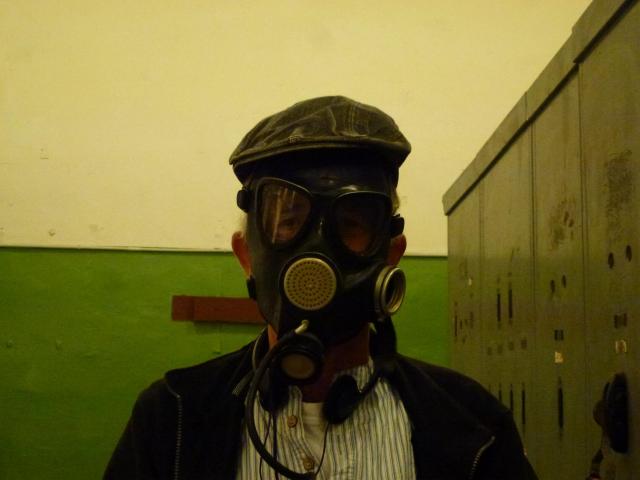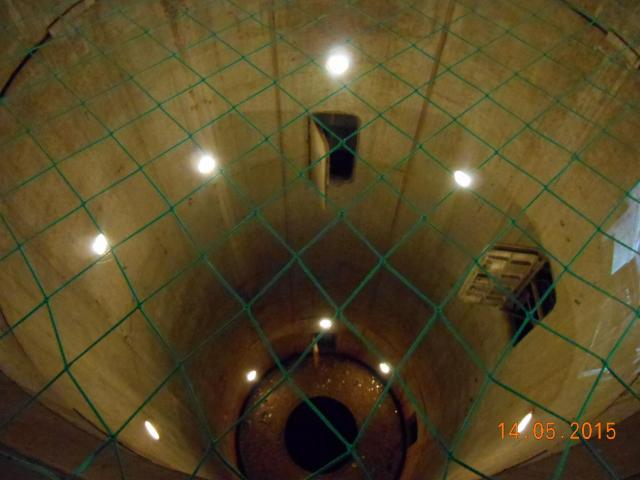The weather in Sventoji was very changable – from brilliant sunshine and shorts one minute to thick cloud cover and thermals the next. We pottered around for an extra day but the wind was blowing a gale so we couldn’t ride our bikes as planned – well we could of but we would probably still be heading in the direction of Poland with the tail-gale-wind we were experiencing.
Our next plan was to find the former nuclear missile base, internet reports were mixed from it was closed down to impossible to find. We struggled with finding anything concrete about it that showed gps and sites that did had coordinates for two places 30 km apart. Taking the chance we headed for the site that seemed most likely, through the forests, 4 km up an un-made road and hey presto Plokstine.
We were told we needed to join a tour to visit, no problem one leaves in 5 minutes. Did we want headphones? yes please. Tour starts, just us two and guide, we get to an extremely thick iron door – she opens it. In we all go, she then says have a good tour and leaves us! Odd but never mind, we had the place to ourselves, well until a complete battalion of the Lithuanian army turned up and joined us doing a tour themselves – all of whom popped there heads around a door to check to give us a nod and a wave.
Iain taking no chances whilst he was there
Plokstine was built in 1960, it was the first USSR underground military base, built in response to those the USA was building – back when showing yours was bigger was what bulk of world money was spent on. There was a network of tunnels and four shafts, nearly 34 metres deep that housed the missiles. The concrete domes would have been moved aside on rails in less than 30 minutes, two Russians would have pushed a button each and launched an R-12 Dvina missile with nuclear warhead, that would have been it – goodnight Europe! Absolutely amazing to visit somewhere that the West didn’t know existed for the first 15 years it was in operation despite it being a threat to life as we know it.
Nuclear missile launching silo
When it was operational there would have been a large compliment of Russian troops manning the facility and a large barracks not too far away in the forest. There was an electric fence surrounding the whole area – normally set to 200v but with the possibility of raising the voltage to 1700v if they felt necessary. As the missiles had a radius of over 1600 miles not sure who they thought was going to be at the fence anytime before they nuked the hell out of them.
What wasn’t made clear was where and how the missiles were removed. The blurb told how the Russians packed up and left the site, but couldn’t imagine them packing up their 40 ton missiles and sneaking off with them without much fuss or any of the locals noticing.
Concrete silo cover
We over-nighted at a campsite on the edge of Siauliai, all looked fine and even joined by three other motorhomes. An hour later we were joined by a minibus of local road builders who appear to live in a hostel at the back of the loos. In order to use the facilities it necessitated running a gauntlet of anything from 4-10 workmen stood outside the loo/ shower door in skimpy towels having a post shower ciggy and beer, – tres chic! we moved on next morning 🙂
Whilst we had visited the Hill of Crosses in Poland, the original and better known Lithuanian version wasn’t too far away so we went for a comparison visit. No-one seems to know exactly when the practice of leaving crosses started in Siauliai but it’s believed to be sometime around 1831. It was be impossible to count how many crosses there were, estimates say anywhere between 250,000 and 500,000. Amongst the crosses are giant crucifixes, statues of Saints, and thousands of rosaries and offerings. During the occupation Lithuanians continued to visit the hill and leave crosses, despite the Soviets best attempts to clear the site which they bulldozed three times.
The most obvious contrast for us was the Lithuanian version is not so much on a hill as a large mound of earth. The crosses are contained in an area a fifth of the size of it’s namesake in Poland but as there seems to be as many if not more crosses. We visited early in the morning so were lucky to see the hill before the pilgrimage tours started, would imagine it gets a bit chaotic on the narrow pathways when the buses come in. Worth a visit for sure, they don;t charge an entry fee but there are plenty of ticky tacky stalls in car-park to spend a few Euro on amber of souvenir crosses and magnets.
Driving through Lithuania it has struck us just how empty the countryside seems, almost as if its been decreed to leave it fallow. Mile after mile of pasture covered in dandelions. The odd square has been ploughed – usually we see it being done by hand – but generally the land is left untouched. Very few livestock, just the obligatory cow outside each cottage, no herds of sheep or cows. It doesn’t feel in anyway backwards or old fashioned – it just feels like no-one has got around to using the land.








gosh iain & Sandra all your story`s & photos on your wonderful travels they are marvellous I just love reading about them the hill of the crosses is so wonderful you both take care xx
LikeLike
Another great post and a useful reference for many to follow………
LikeLike
Fantastic, the nuclear missile base looks absolutely fascinating. We loved that whole coastline with the long, white sandy (and windy!) beaches. Have fun, Shaun and Jude.
LikeLike
I spent my teenage years at the height of the cold war terrified one of those things would come my way – nice to see the silos empty. Weather’s a bit changeable here too – I’d be tempted to go back south!!!
LikeLike
Loving it!! Xx
LikeLike